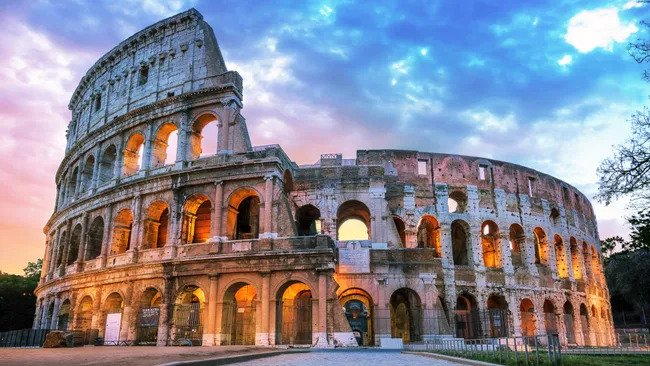Top 50 Fascinating Facts About the Roman Colosseum
One of the most recognizable representations of ancient Rome and a feat of engineering and design is the Roman Colosseum, also called the Flavian Amphitheatre. Built between 70 and 80 AD by the Flavian dynasty’s Vespasian and Titus emperors, this enormous amphitheater had space for 50,000–80,000 spectators.
Gladiatorial combat, public shows, animal hunts, executions, and plays that recreated historical battles—often with legendary themes—were all intended to take place there. The purpose of these gatherings was to amuse the populace and showcase the Roman Empire’s wealth and strength.

The Colosseum is one of the biggest amphitheaters ever constructed, measuring 48 meters (157 feet) in height, 189 meters (620 feet) in length, and 156 meters (512 feet) in width. Four storeys of arcades and columns in Doric, Ionic, and Corinthian styles make up its intricate design, which emphasizes the Romans’ skill of structural construction and architecture.
The best seats were designated for the Roman nobility, although there was seating all around the elliptical arena for viewers of all social classes. Gladiators and beasts awaited their arrival in a maze of subterranean passageways (hypogeum) hidden beneath the sand-covered, wood-framed arena surface.
Even though the Colosseum has been damaged by fires, earthquakes, and stone looting over the years, a large portion of its construction has survived. It is now one of the New Seven Wonders of the World and a UNESCO World Heritage Site. The remains of a monument that once symbolized the magnificence of ancient Rome and the rich, intricate history of Roman entertainment and society draw millions of tourists to the Colosseum every year.
Here, we’ll uncover 50 unknown and interesting facts about the Roman Colosseum that make this ancient wonder even more captivating.
1. The Colosseum Wasn’t Its Original Name
- The Romans called it the “Amphitheatrum Flavium,” after the emperors of the Flavian dynasty who commissioned it. The name “Colosseum” only came about due to the nearby Colossus of Nero statue.
2. Built on a Man-Made Lake
- Emperor Nero’s artificial lake was drained to create a flat foundation for the Colosseum. The arena’s construction was part of an effort to “give Rome back to the people” after Nero’s reign.
3. It Took Less Than a Decade to Build
- Construction of the Colosseum began in AD 72 under Emperor Vespasian and was completed in AD 80 by his son Titus, an impressive timeline for such a monumental structure.
4. Funded by Spoils of War
- The funding for the Colosseum largely came from treasures taken from the Jewish Temple after the Romans defeated Jerusalem in AD 70.
5. Could Host 50,000-80,000 Spectators
- The Colosseum could hold between 50,000 to 80,000 spectators, making it one of the largest arenas ever built, capable of housing nearly the population of a small city.
6. Had a Complex System of Tiers
- Seating was carefully arranged by social class: emperors and senators sat closest to the action, while women and lower-class citizens were relegated to the upper tiers.
7. A Retractable Awning Called the “Velarium”
- The Colosseum was equipped with an enormous retractable awning, the velarium, which shaded spectators and kept them cool.
8. The Arena Floor Could Be Flooded
- For naval battle re-enactments, the Colosseum’s floor was specially designed to be flooded with water, turning it into a large, temporary lake.
9. Home to Gladiator Battles, Beast Hunts, and Executions
- Events included not only gladiator battles but also beast hunts, public executions, and elaborate reenactments of historical battles.
10. Animal Species from All Over the Empire
- Exotic animals like elephants, leopards, lions, and even crocodiles were brought to the Colosseum for events, showcasing Rome’s global reach.
11. Over 500,000 People Died in the Colosseum
- Scholars estimate that more than 500,000 people and over a million animals were killed in events over the Colosseum’s active years.
12. A Massive System of Underground Tunnels (Hypogeum)
- The hypogeum, a vast network of tunnels beneath the arena floor, allowed for intricate staging, including trapdoors and animal cages, enhancing the dramatic impact of events.
13. The Hypogeum Had Elevators and Pulley Systems
- Ingenious pulley and elevator systems helped lift animals, scenery, and gladiators into the arena, adding to the spectacle of performances.
14. Events Were Free to Attend
- Entry to events was free for Roman citizens, sponsored by the emperor or wealthy individuals to gain public favor.
15. An Earthquake Damaged the Colosseum in 1349
- A massive earthquake caused part of the Colosseum’s southern wall to collapse, which is why the structure appears incomplete today.
16. The Colosseum’s Stones Were Repurposed
- After its active years, the Colosseum served as a “quarry” for nearby structures, with stones and marble taken for building projects like St. Peter’s Basilica.
17. An Emblem of the Christian Faith
- The Colosseum is recognized by the Catholic Church as a symbol of Christian martyrdom, with an annual Good Friday procession held there.
18. Not Just Gladiators: Athletes and Performers, Too
- The Colosseum hosted a variety of athletic events, theatrical performances, and public speeches in addition to gladiator battles.
19. Built by Over 100,000 Slaves
- A workforce primarily composed of enslaved individuals constructed the Colosseum, reflecting the massive human effort behind its creation.
20. One of Rome’s First Restrooms
- The Colosseum had facilities, including latrines, which were among the first public restrooms available in Rome.
21. Its Structure Was Fireproof
- Much of the Colosseum’s outer structure was built with tufa, a fireproof stone that contributed to the arena’s durability.
22. There Were VIP Boxes
- Special VIP boxes existed for the emperor and other elite guests, positioned for the best view of the arena.
23. A Model of Ancient Engineering
- Roman engineers developed advanced drainage systems to handle the vast crowds and the potential flooding during naval reenactments.
24. Became a Castle for Nobles in the Middle Ages
- After falling into disuse as an arena, the Colosseum was fortified and used as a residence by noble families during the Middle Ages.
25. Symbol of Modern Anti-Capital Punishment Movement
- The Colosseum is illuminated whenever a country abolishes the death penalty, symbolizing Rome’s stance against capital punishment.
26. Marble Facade Was Stripped Away
- Marble that once adorned the Colosseum was removed over time and used in various other construction projects in Rome.
27. Inspired Modern Stadiums
- Its tiered seating, entryways, and overall design have influenced modern stadiums around the world.
28. Each Entrance Was Numbered
- Each of the Colosseum’s entrances was numbered, allowing for a smooth entry and exit of tens of thousands of people.
29. Renovated Over 200 Times
- During its active years, the Colosseum underwent over 200 modifications and renovations.
30. Amphorae Underneath for Stability
- Clay pots known as amphorae were used in the foundations to absorb the vibrations caused by the massive crowds, a brilliant early form of earthquake resistance.
31. Free Bread Was Distributed to Spectators
- Free bread was often distributed to keep the crowds content, a practice that also helped maintain public order.
32. The Colosseum’s Original Outer Wall Was 157 Feet High
- The structure originally stood at a staggering height of 157 feet (48 meters), equivalent to a 12-story building.
33. An Advanced Ticketing System
- Romans received tickets in the form of pottery shards, indicating their entrance and seating assignment.
34. Gladiator Battles Were Not Always Fights to the Death
- Contrary to popular belief, gladiator fights didn’t always end in death; many fights were judged on skill and bravery.
35. A Miniature Ecosystem Thrives in Its Ruins
- Over 400 species of plants have been identified growing within the ruins of the Colosseum, some unique to the area.
36. Mosaics and Artwork Once Adorned the Arena
- The Colosseum’s interior was once decorated with mosaics and paintings, though most have eroded over the centuries.
37. Held over 100 Days of Inaugural Games
- To celebrate its completion, Emperor Titus held 100 days of continuous games, featuring gladiatorial contests, wild animal hunts, and more.
38. Used as a Christian Church
- In the 18th century, Pope Benedict XIV consecrated the Colosseum as a Christian site in memory of the martyrs believed to have died there.
39. Rome’s Largest Building of Its Time
- At the time of its completion, the Colosseum was the largest freestanding building in Rome.
40. Ancient Graffiti in the Hypogeum
- Graffiti and markings from ancient times can still be seen in the hypogeum, some made by those who worked within the Colosseum.
41. The Arena Had Trapdoors
- There were more than 36 trapdoors on the arena floor, which could be used to surprise spectators with sudden appearances of animals or performers.
42. Its Famous Arches Are Made of Travertine
- Travertine stone from Tivoli, Italy, was used for the iconic arches, which were designed to support the structure while allowing flexibility.
43. The Gladiators Had Their Own Barracks Nearby
- Gladiators lived in the Ludus Magnus, a barracks close to the Colosseum where they trained and prepared for fights.
44. The Colosseum Was Part of the Urban Landscape
- The Colosseum was not isolated but part of the bustling Roman city, surrounded by temples, baths, and markets.
45. The Romans Mastered Crowd Control
- The Colosseum was designed for crowd control, with multiple entrances, passageways, and efficient evacuation routes.
46. Naval Battle Re-enactments Were a Popular Attraction
- The Colosseum’s floor could be flooded for naval battle reenactments, a feat of Roman engineering.
47. It Was a Platform for Imperial Propaganda
- Emperors used the Colosseum’s games to showcase their power, generosity, and military victories, reinforcing their authority in Rome.
48. The Colosseum Once Had an Exterior Covered in Marble
- The Colosseum’s exterior was once covered in fine marble, but it was looted during the medieval period.
49. It Was a Monument to Imperial Rome’s Dominance
- The Colosseum symbolized Roman dominance, not just through its size and grandeur but in the spectacles it hosted that demonstrated Roman superiority.
50. A Global Icon of Ancient Rome
- Today, the Colosseum is a UNESCO World Heritage Site and remains one of the most recognized symbols of ancient Rome, attracting millions of visitors each year.

